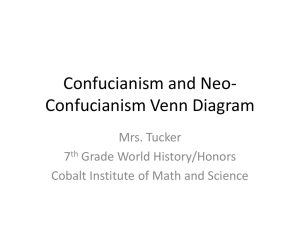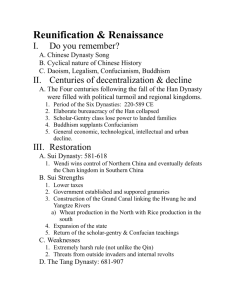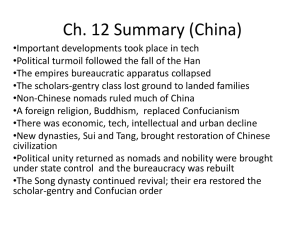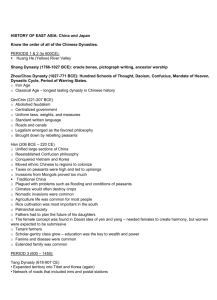China Unit Big Ideas and Essential Questions
advertisement
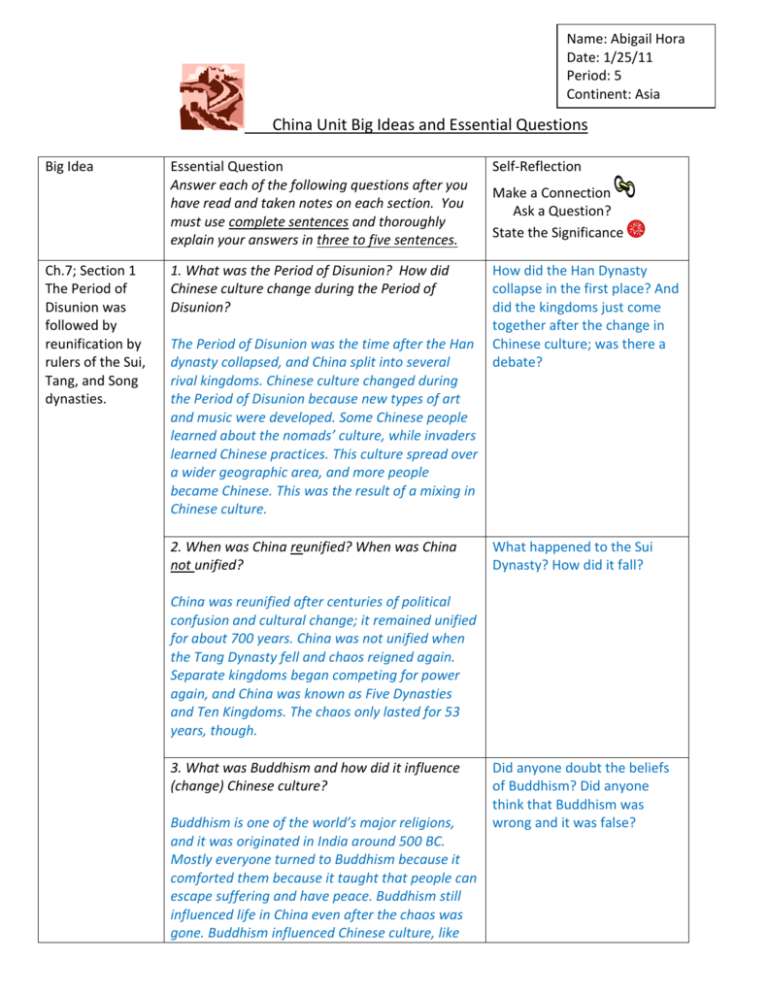
Name: Abigail Hora Date: 1/25/11 Period: 5 Continent: Asia China Unit Big Ideas and Essential Questions Big Idea Ch.7; Section 1 The Period of Disunion was followed by reunification by rulers of the Sui, Tang, and Song dynasties. Essential Question Answer each of the following questions after you have read and taken notes on each section. You must use complete sentences and thoroughly explain your answers in three to five sentences. Self-Reflection 1. What was the Period of Disunion? How did Chinese culture change during the Period of Disunion? How did the Han Dynasty collapse in the first place? And did the kingdoms just come together after the change in Chinese culture; was there a debate? The Period of Disunion was the time after the Han dynasty collapsed, and China split into several rival kingdoms. Chinese culture changed during the Period of Disunion because new types of art and music were developed. Some Chinese people learned about the nomads’ culture, while invaders learned Chinese practices. This culture spread over a wider geographic area, and more people became Chinese. This was the result of a mixing in Chinese culture. 2. When was China reunified? When was China not unified? Make a Connection Ask a Question? State the Significance What happened to the Sui Dynasty? How did it fall? China was reunified after centuries of political confusion and cultural change; it remained unified for about 700 years. China was not unified when the Tang Dynasty fell and chaos reigned again. Separate kingdoms began competing for power again, and China was known as Five Dynasties and Ten Kingdoms. The chaos only lasted for 53 years, though. 3. What was Buddhism and how did it influence (change) Chinese culture? Buddhism is one of the world’s major religions, and it was originated in India around 500 BC. Mostly everyone turned to Buddhism because it comforted them because it taught that people can escape suffering and have peace. Buddhism still influenced life in China even after the chaos was gone. Buddhism influenced Chinese culture, like Did anyone doubt the beliefs of Buddhism? Did anyone think that Buddhism was wrong and it was false? art, literature, and architecture. The period from 400 to about 485 was even called The Age of Buddhism because it was so popular. The Age of Buddhism came to an end when a Tang emperor fought against it by burning Buddhist texts, taking land from Buddhist temples, destroyed the temples, and turned some into schools. But Buddhism still continued to thrive in Chinese society, and it still shaped Chinese art and literature. Soon, Buddhism elements were combined with other religions, like Daoism and Confucianism. Ch.7; Section 2 The Tang and Song dynasties were periods of economic, cultural, and technological accomplishments. Explain what advances in agriculture and farming led to increased trade and population growth during the Song dynasty. How did they build The Dragon Backbone? Did they switch places with the one person who used The Dragon Underground wells were made for irrigation, and Backbone regularly like a an irrigation machine called The Dragon Backbone cycle? helped one person do the work of many people. The Dragon Backbone was used to help create unique irrigation systems for farming. A new type of fast-ripening rice helped farms become more productive. Farmers also learned how to grow new crops, like cotton, which was used for clothes and other goods. China’s population began to grow because of the large amounts of food; at the time, China was the largest country in the world. And the trade in many of China’s cities made China richer than ever. Ch.7; Section 3 Confucian thought influenced the Song government. What is Confucianism and what are the main teachings of Confucian philosophy? Confucianism is a belief based on the teachings of Confucius. The main teachings of Confucian philosophy are ethics and proper behavior. Ren, concern for others, and li, appropriate behavior, were the two things that people should conduct according to their lives. Confucius thought that everyone had a role in society. How did Confucianism differ from NeoConfucianism? Confucianism differed from Neo-Confucianism because Neo-Confucianism also used spiritual matters that involved Buddhist and Daoist What did Confucius do before he became famous for creating Confucianism? What was his job, and what was his life like? How come Neo-Confucianism became more important than the original Confucianism? Why didn’t they use Confucianism for government teachings along with Neo- Ch.7; Section 4 The Chinese were ruled by foreigners during the Yuan dynasty, but they threw off Mongol rule and prospered during the Ming dynasty. concepts about the meaning of life. And unlike Confucianism, Neo-Confucianism became part of official government teachings AFTER the Song Dynasty. Confucianism? How did the Mongols come to rule China during the Yuan dynasty? What was Genghis Khan’s life like before he was leader of the Mongols? What was his childhood and grownup life like? The Mongols came to rule China during the Yuan Dynasty because a vicious leader named Genghis Khan built up a powerful army of Mongols. He tore down every city and village he went through, and he soon focused his sights on China. Genghis Khan blazed through China, tearing everything down in his path and making it his. By the time of his death, Genghis Khan had northern China under Mongol Control. How did the Yuan dynasty come to an end? The Yuan Dynasty came to an end because the Mongols were weakened when their fleet of ships was destroyed during a storm; they were going to conquer Japan. The rest of China took the chance to rebel against the Mongols, so a former monk named Zhu Yuanzhang built up an army. He led the army in to battle, and he came out victorious. China was ruled by the Chinese once again. In what ways did the Ming dynasty strengthen China and bring a period of stability and prosperity? The Ming Dynasty strengthened China because Zheng He brought a fleet of ships from China with him to different places. He bragged about his country, and the leaders of the places sent a representative bearing gifts for China’s emperor. More people began to support the emperor as he became popular. And Zheng He’s fleet of ships showed that China had a lot of money and power. This brought a period of stability and prosperity because Zheng He also brought wonderful gifts from China to the many leaders. Did Japan know that the Mongols were coming to invade their land? And how did Zhu Yuanzhang become the leader of the rebel army? What kind of gifts did Zheng He give the leaders of the other places to make them so willing to join the emperor? Did the leaders ever become allies with China, and then become their enemies?

